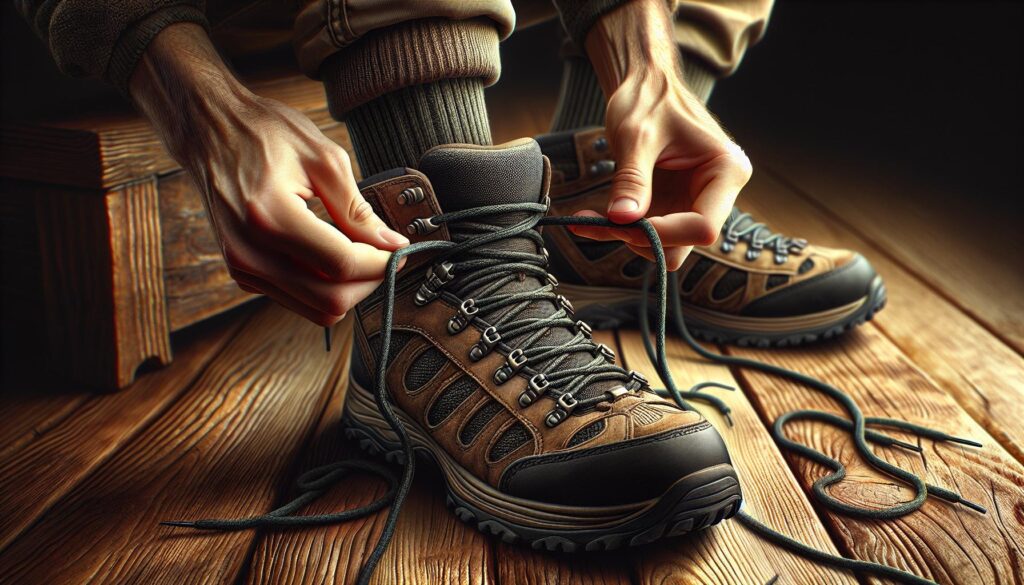Tying hiking shoes might appear like a basic task, but correctly lacing them for optimal comfort and stability can truly elevate your hiking experience. Starting with the bottom eyelets, thread the lace diagonally, crossing it into the next set of eyelets, repeating until you reach the top. Mastering the lock lacing can take your hikes to new heights.
Finding the right lacing technique for your hiking shoes not only assures a firm and comfortable fit, it also helps prevent blisters, providing improved ankle support. Whether you are a novice or seasoned hiker, understanding how to lace your boots correctly is crucial. Keep reading as we guide you through each step in the process to maximize comfort and stability on the trails.
Life’s a hike, start walking. Let’s understand how to lace your hiking boots properly and enhance your boots’ effectiveness for your next adventure.
Table of Contents
1. Identifying the Ideal Lacing Technique for Your Feet
Lacing techniques for hiking boots isn’t one size fits all. Your unique foot structure, including shape and arch support, play a crucial role in deciding the perfect lacing style. You must find a lacing method that gives optimal support and comfort for your foot type. Understanding varied lacing patterns and their benefits can help you customize your hiking boots’ fit. For instance, a lacing method that gives extended volume in the midfoot area can provide relief to those with high arches. Contrarily, if you have flat feet, a lace pattern that proffers added support and stability can make all the difference. Considering these aspects can guarantee your hiking shoes fit snugly and comfortably.
2. Boosting Comfort and Stability with Appropriate Lacing
A well-executed lacing technique can significantly amplify the comfort and stability of your hiking boots. The heel lock lacing technique can be highly beneficial, this involves creating loops on either side of the shoe’s eyelets and then interweaving the laces through these loops to secure the heel in place, avoiding any slip. Furthermore, utilizing the surgeon’s knot method can ensure your laces stay tight throughout your trek. Customizing your lacing methods according to your specific foot conditions is also crucial. Experimenting with various lacing techniques can help you find the right mix that enhances both comfort and stabilization.
3. Lacing Hiking Boots for Specific Outdoor Activities
You must consider the nature of activity and the terrain before lacing up your hiking shoes. For instance, using the “heel lock” technique can improve stability and avert heel slippage while hiking on rugged terrains. Runners might prefer the “runner’s loop” technique to prevent foot movement within the shoe. Choosing the right lacing technique can ensure the best fit, security, and comfort for specific outdoor activities.
4. Customizing Laces for Temperature and Terrain Changes
It’s essential to adjust your laces depending on the weather and terrain changes. In warm weather conditions, loosening the laces can prevent discomfort by allowing better airflow. Conversely, tightening the laces can provide added stability and prevent slips on unstable or rough terrains. Consulting with hiking experts or guides can provide further insight on how to regulate your laces for maximizing your hiking performance.
5. Mastering Knots and Adjusting Tension
Choosing the appropriate knot type can significantly affect your lacing technique. Like a square knot, a surgeon’s knot or a double slip knot can ensure a secure fit and prevent shoes from coming undone mid-hike. Striking a balance between snugness and flexibility can maximize comfort. Make sure your shoes are snug enough to endure the trek but also flexible enough to accommodate toe movement.
6. Caring for and Replacing Laces for Longevity
Regular maintenance and timely replacement of laces can prolong the longevity of your hiking boots, avoiding any unwanted shoe mishaps during your hiking escapades. By keeping track of your laces’ condition, you can prevent any premature wear and tear, ensuring a smooth and enjoyable hiking experience at all times.
At the end of the day, a well-laced hiking shoe can make all the difference between a pleasurable hiking experience and a painful trek. By following these methods for lacing your hiking shoes, you can ensure the best comfort and stability for every step of your hiking journey. Invest some extra time lacing your hiking shoes properly, and reap the benefits on your next trail adventure.
So, ready to lace up and hit the trails? Happy Hiking!
Successfully lacing hiking footwear isn’t simply putting a thread through holes. It’s an art form that precisely ties the shoes for unrivaled comfort and stability, enhancing your hiking experience. The process involves threading the lace through the bottom-eyelets before crisscrossing to the top. This seemingly straightforward method can make a significant difference in your hiking experience.
Adopting the right lacing strategy is key to ensuring a comfortable, secure fit, reducing the chances of blisters, and providing enhanced ankle support. This knowledge is integral to all hikers, beginners, and experienced outdoor enthusiasts alike. This guide will elucidate the steps involved in properly lacing hiking shoes, helping you achieve the utmost comfort and stability on your trails.
Let’s get down to lacing up your hiking shoes in readiness for your next outdoor adventure.
1. Deciphering the Perfect Lacing Method for Your Feet
When it concerns lacing hiking shoes, it’s paramount to figure out the perfect technique tailored to your foot type. Your foot structure, including your arch support, factors decisively in your choice of lacing pattern. The right lacing style provides requisite comfort and support for your feet. Factoring in these variables allows you to ensure a secure, comfortable fit for your hiking footwear.
2. Augmenting Comfort and Stability with Adequate Lacing
The right lacing techniques can noticeably enhance the fit and stability of your hiking shoes. Diverse techniques like the heel lock lacing method or the surgeon’s knot cater to your specific foot conditions, making your hiking shoes more comfortable and durable.
3. Lacing Hiking Shoes for Distinct Outdoor Adventures
Lacing hiking shoes appropriately considering the terrain and activity is absolutely vital. Techniques like the ”heel lock” are beneficial for rugged terrains, providing added stability and avert heel slip. Selecting the right lacing method ensures a secure, comfortable fit for your particular outdoor activity.
4. Customizing Laces for Varying Temperatures and Terrains
Lace adjustments corresponding to changes in temperature and terrains can significantly enhance your hiking experience, ensuring a secure fit for any condition. It is important to loosen laces in hot weather for improved airflow and comfort, while tightening laces for rough terrains provides stability and prevents slips.
5. Mastering the Art of Knot Tying and Tension Adjustments
Choosing the correct knot can dramatically affect your hiking experience. Different strategies call for different knots to ensure a secure and comfort fit throughout your hike. Also, achieving the perfect balance between snugness and flexibility is key to optimal comfort.
6. Caring for and Replacing Laces for Longevity of Hiking Shoes
Regular care and timely replacement of laces is a vital aspect of your hiking shoe’s long life, saving you from unexpected shoe disasters during your hikes. Keep track of the condition of your laces and prevent any premature wear and tear for a smooth and satisfying hiking experience.
Frequently Asked Questions About Lacing Hiking Shoes
How Do You Lace Hiking Shoes Properly?
For lacing hiking shoes properly, begin by loosening the laces and correctly positioning your foot inside the shoe. Subsequently, crisscross the laces, pulling them firmly to provide support and prevent slips. Lastly, tie a firm knot at the top to keep the laces in place during your hike.
What Lacing Technique is Best for Preventing Toe Discomfort?
The toe lock lacing technique can prevent toe discomfort while hiking. This strategy involves creating a loop with each lace and feeding it through the opposing loop while pulling it tight, ensuring a snug fit and reducing potential discomfort significantly.
Can Different Lacing Techniques Apply to Different Terrains?
Indeed, different lacing techniques are beneficial for varying terrains. The heel lock technique is ideal for steep slopes, preventing foot slide, while the window lacing technique can offer greater flexibility for uneven terrain by tightness adjustment for specific areas.
How Can Blisters During Hiking be Prevented?
Wearing a proper fit, using moleskin or blister pads for protection, and wearing moisture-wicking socks can all help in preventing blisters while hiking. It’s important to break in your shoes before a long hike and stop immediately at the sign of any discomfort.
Conclusion
Mastering the art of lacing hiking shoes is imperative for a comfortable, secure hiking experience. No matter what type of lacing pattern you opt for, finding the correct fit and maintaining appropriate tension will help prevent injuries and discomfort.
So, with this guide in your arsenal, don’t underestimate the significance of correctly lacing your hiking shoes the next time you hit the trails. Remember, a good hiking experience begins with a good lace up. Here’s to happy hiking!
Heading out on a hike? Don’t underestimate the importance of lacing your shoes correctly. This simple process, starting with threading through the bottom eyelets and then crisscrossing all the way up to the top, can dramatically enhance your hiking experience. Read on to discover how to achieve the perfect lace-up for comfort and stability on the trails.
A correctly laced shoe can offer you a firm yet comfortable fit, lower the risk of blisters, and offer improved support around the ankles. These are crucial elements whether you’re new to hiking or an experienced trailblazer. This guide will stride you through the process of properly lacing your hiking shoes, setting you up for successful comfort and balance on your adventures.
Ready to tie up and tackle the trails? Let’s lace up for adventure!
1. Yourself on the Right Foot with the Correct Lacing Technique
To lace hiking shoes effectively, it’s important to consider the unique shape and arch support of your feet. The correct lacing strategy can lead to enhanced comfort and support for your specific foot type. Knowing different lacing patterns and understanding their benefits allows you to customize the fitting of your shoes, ensuring they snugly hug your feet on your outdoor pursuits.
2. Clutching Comfort and Stability with Fine-tuned Lacing
Right lacing techniques can significantly boost both the comfort and stability of your shoes. Techniques like the heel lock lacing method can lend a help to the heel, preventing its movement. Furthermore, adopting the surgeon’s knot method can prevent your laces from loosening, securing your foot within the shoe.
3. Tailoring your Lacing Technique to your Hiking Activity
The terrain type and the purpose of your outdoor activity should influence your lacing method. For rough trails, using strategic techniques like “heel lock” ensures added stability and reduces heel slippage. Ultimately, the right choice of a lacing method can greatly enhance the security and comfort of your hiking shoes for specific outdoor activities.
4. Adapting Laces to Varied Temperatures and Terrains
Adjusting your laces according to weather variations and the nature of terrain can go a long way in enhancing your hiking experience. For example, loosening the laces can alleviate discomfort and improve airflow in hot conditions. Conversely, tightening the laces can bestow added stability while traversing rough terrains.
5. Tying it all Together – Knots and Tension Adjustment
The right choice of knot can greatly influence your lacing strategy. Popular knot options like the square knot, surgeon’s knot, or double slip knot ensure effective lacing. Also, achieving a balance between snugness and flexibility is key to comfort.
6. Preserving and Swapping Laces for the Longevity of your Hiking Shoes
Regular care and timely replacement of laces can prolong the life of your hiking shoes, saving you from surprise shoe challenges mid-hike. Staying on top of the condition of your laces can prevent premature wear and tear, making for a smooth and enjoyable hiking experience.
Frequently Asked Questions about Lacing Hiking Shoes
How Do You Lace Hiking Shoes Properly?
To lace hiking shoes correctly, start with loose laces, ensuring your foot is well-positioned inside. Then crisscross laces up the shoe, pulling them snug and finally, bind them with a secure knot at the top to keep the laces in place.
What Lacing Technique is Ideal to Prevent Toe Discomfort?
The toe lock lacing technique is perfect for preventing toe discomfort while hiking. This method ensures a snug fit around your toes, thereby minimizing unwanted movement and potential discomfort.
Can Different Laces be Used for Different Terrains?
Indeed, different lacing techniques are beneficial for different types of terrains. For instance, the heel lock technique can help secure your foot while walking on steep inclines or descents. The window lacing technique allows you to adjust the tightness around specific areas of the shoe to better suit uneven terrains.
How Can Blisters be Prevented While Hiking?
To prevent blisters, ensure your shoes fit properly and use moleskin or blister pads for added protection. In addition, moisture-wicking socks can help reduce friction and keep your feet dry. It is vital to break in your shoes before a long hike and pause if you begin to encounter discomfort or irritation.
Conclusion
Masterfully lacing your hiking shoes can be instrumental in paving the way for a smooth and secure hiking experience. Regardless of your lacing pattern preference, getting it right can enhance your comfort and prevent injury. So before you next set foot on the trail, remember, those laces are there for more than just looks – here’s to great adventures with well-laced, comfortable, and secure shoes! Happy hiking!














